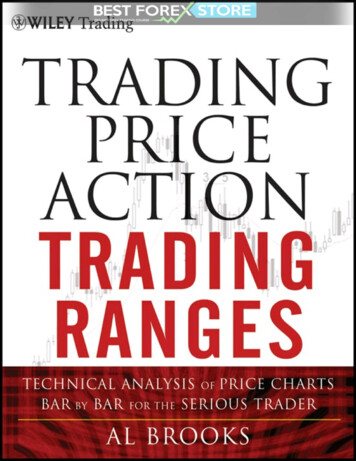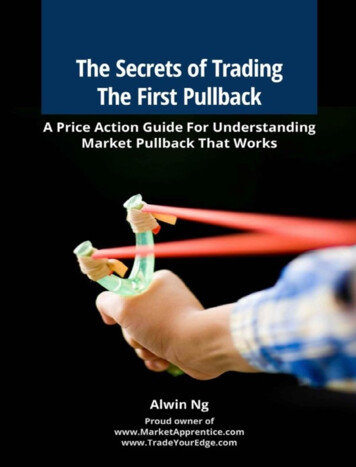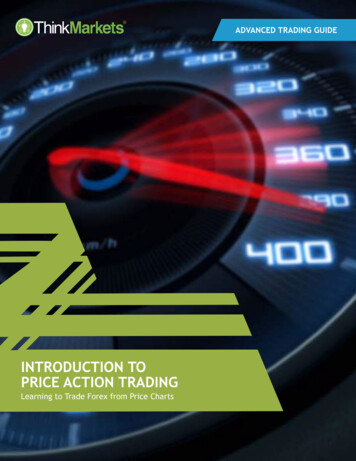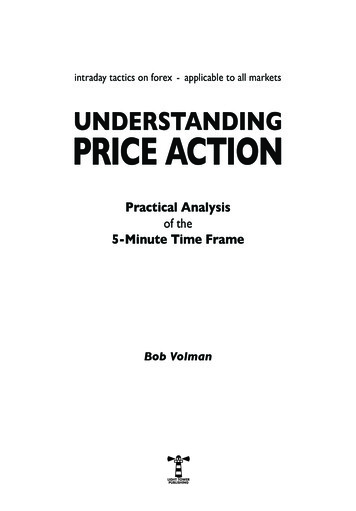
Transcription
ContentsCoverSeriesTitle PageCopyrightDedicationAcknowledgmentsList of Terms Used in This BookIntroductionHOW TO READ THESE BOOKSSIGNS OF STRENGTH: TRENDS, BREAKOUTS, REVERSAL BARS, AND REVERSALSBAR COUNTING BASICS: HIGH 1, HIGH 2, LOW 1, LOW 2Part I: Breakouts: Transitioning into a New TrendChapter 1: Example of How to Trade a BreakoutChapter 2: Signs of Strength in a BreakoutChapter 3: Initial BreakoutChapter 4: Breakout Entries in Existing Strong TrendsChapter 5: Failed Breakouts, Breakout Pullbacks, and Breakout TestsChapter 6: GapsPart II: Magnets: Support and ResistanceChapter 7: Measured Moves Based on the Size of the First Leg (the Spike)Chapter 8: Measured Moves Based on Gaps and Trading RangesChapter 9: Reversals Often End at Signal Bars from Prior Failed ReversalsChapter 10: Other MagnetsPart III: Pullbacks: Trends Converting to Trading RangesChapter 11: First Pullback Sequence: Bar, Minor Trend Line, Moving Average, Moving
Average Gap, Major Trend LineChapter 12: Double Top Bear Flags and Double Bottom Bull FlagsChapter 13: Twenty Gap BarsChapter 14: First Moving Average Gap BarsChapter 15: Key Inflection Times of the Day That Set Up Breakouts and ReversalsChapter 16: Counting the Legs of Trends and Trading RangesChapter 17: Bar Counting: High and Low 1, 2, 3, and 4 Patterns and ABC CorrectionsChapter 18: Wedge and Other Three-Push PullbacksChapter 19: Dueling Lines: Wedge Pullback to the Trend LineChapter 20: “Reversal” Patterns: Double Tops and Bottoms and Head and Shoulders Topsand BottomsPart IV: Trading RangesChapter 21: Example of How to Trade a Trading RangeChapter 22: Tight Trading RangesChapter 23: TrianglesPart V: Orders and Trade ManagementChapter 24: Scalping, Swinging, Trading, and InvestingChapter 25: Mathematics of Trading: Should I Take This Trade? Will I Make Money If I TakeThis Trade?THE TRADER'S EQUATIONDIRECTIONAL PROBABILITYChapter 26: Need Two Reasons to Take a TradeChapter 27: Entering on StopsChapter 28: Entering on LimitsChapter 29: Protective and Trailing StopsChapter 30: Profit Taking and Profit TargetsChapter 31: Scaling Into and Out of a Trade
Chapter 32: Getting Trapped In or Out of a TradeAbout the AuthorAbout the WebsiteIndex
Founded in 1807, John Wiley & Sons is the oldest independent publishing company in the United States. With offices in North America, Europe,Australia, and Asia, Wiley is globally committed to developing and marketing print and electronic products and services for our customers'professional and personal knowledge and understanding.The Wiley Trading series features books by traders who have survived the market's ever changing temperament and have prospered—some byreinventing systems, others by getting back to basics. Whether a novice trader, professional, or somewhere in-between, these books will providethe advice and strategies needed to prosper today and well into the future.For a list of available titles, please visit our Web site at www.WileyFinance.com.
Copyright 2012 by Al Brooks. All rights reserved.The first edition of this book, titled Reading Price Charts Bar by Bar: The Technical Analysis of Price Action for the Serious Trader, waspublished in 2009.Published by John Wiley & Sons, Inc., Hoboken, New Jersey.Published simultaneously in Canada.All charts were created with TradeStation. TradeStation Technologies, Inc. All rights reserved.No part of this publication may be reproduced, stored in a retrieval system, or transmitted in any form or by any means, electronic, mechanical,photocopying, recording, scanning, or otherwise, except as permitted under Section 107 or 108 of the 1976 United States Copyright Act, withouteither the prior written permission of the Publisher, or authorization through payment of the appropriate per-copy fee to the Copyright ClearanceCenter, Inc., 222 Rosewood Drive, Danvers, MA 01923, (978) 750-8400, fax (978) 646-8600, or on the Web at www.copyright.com. Requests tothe Publisher for permission should be addressed to the Permissions Department, John Wiley & Sons, Inc., 111 River Street, Hoboken, NJ 07030,(201) 748-6011, fax (201) 748-6008, or online at http://www.wiley.com/go/permissions.Limit of Liability/Disclaimer of Warranty: While the publisher and author have used their best efforts in preparing this book, they make norepresentations or warranties with respect to the accuracy or completeness of the contents of this book and specifically disclaim any impliedwarranties of merchantability or fitness for a particular purpose. No warranty may be created or extended by sales representatives or written salesmaterials. The advice and strategies contained herein may not be suitable for your situation. You should consult with a professional whereappropriate. Neither the publisher nor author shall be liable for any loss of profit or any other commercial damages, including but not limited tospecial, incidental, consequential, or other damages.For general information on our other products and services or for technical support, please contact our Customer Care Department within theUnited States at (800) 762-2974, outside the United States at (317) 572-3993 or fax (317) 572-4002.Wiley also publishes its books in a variety of electronic formats. Some content that appears in print may not be available in electronic books. Formore information about Wiley products, visit our web site at www.wiley.com.Library of Congress Cataloging-in-Publication Data:Brooks, Al, 1952–Trading price action trading ranges : technical analysis of price charts bar by bar for the serious trader / Al Brooks.p. cm. – (The Wiley trading series)“The first edition of this book titled, Reading price charts bar by bar : the technical analysis of price action for the serious trader, was published in2009”–T.p. verso.Includes index.ISBN 978-1-118-06667-6 (cloth); ISBN 978-1-118-17231-5 (ebk);ISBN 978-1-118-17232-2 (ebk); ISBN 978-1-118-17233-9 (ebk)1. Stocks–Prices–Charts, diagrams, etc. I. Brooks, Al, 1952– Reading price charts bar by bar. II. Title.HG4638.B757 2012332.63′2042–dc232011029299
I would like to dedicate this book to my daughter, Skylar Brooks, who is tender, sweet, sensitive, incredibly accomplished, trusting, andpersistently hopeful. She wants the world to be a better place and is doing far more than the rest of us to make it happen.
AcknowledgmentsMy primary goal is to present a series of comprehensive books on price action, and the greatest concern among readers was how difficult myearlier book, Reading Price Charts Bar by Bar, was to read. I am deeply appreciative of all of the constructive comments that readers haveprovided and those from the participants in my daily live webinars. Many of these comments were incredibly insightful and I have incorporated themin this current edition. I am also thankful to all of the traders who have been in my live trading room, because they have given me the opportunity tosay things repeatedly until I could clearly articulate what I am seeing and doing. They have also asked many questions that have helped me find thewords to communicate more effectively, and I have put those words in these books.I would like to give a special thank-you to Victor Brancale, who spent long hours proofreading the manuscripts and providing hundreds of veryhelpful edits and suggestions, and to Robert Gjerde, who built and administers my website and has given me candid feedback on the chat roomand the website. Finally, I want to thank Ginger Szala, the Group Editorial Director of Futures magazine, for giving me ongoing opportunities topublish articles and speak in webinars, and for regularly giving me very helpful advice on how to become more involved with the trading community.
List of Terms Used in This BookAll of these terms are defined in a practical way to be helpful to traders and not necessarily in the theoretical way often described by technicians.always in If you have to be in the market at all times, either long or short, this is whatever your current position is (always in long or always inshort). If at any time you are forced to decide between initiating a long or a short trade and are confident in your choice, then the market is inalways-in mode at that moment. Almost all of these trades require a spike in the direction of the trend before traders will have confidence.barbwire A trading range of three or more bars that largely overlap and one or more is a doji. It is a type of tight trading range with prominenttails and often relatively large bars.bar pullback In an upswing, a bar pullback is a bar with a low below the low of the prior bar. In a downswing, it is a bar with a high above thatof the prior bar.bear reversal A change in trend from up to down (a bear trend).blown account An account that your losses have reduced below the minimum margin requirements set by your broker, and you will not beallowed to place a trade unless you deposit more money.breakout The high or low of the current bar extends beyond some prior price of significance such as a swing high or low, the high or low ofany prior bar, a trend line, or a trend channel.breakout bar (or bar breakout) A bar that creates a breakout. It is usually a strong trend bar.breakout mode A setup where a breakout in either direction should have follow-through.breakout pullback A small pullback of one to about five bars that occurs within a few bars after a breakout. Since you see it as a pullback,you are expecting the breakout to resume and the pullback is a setup for that resumption. If instead you thought that the breakout would fail,you would not use the term pullback and instead would see the pullback as a failed breakout. For example, if there was a five-bar breakoutabove a bear trend line but you believed that the bear trend would continue, you would be considering shorting this bear flag and not looking tobuy a pullback immediately after it broke out to the downside.breakout test A breakout pullback that comes close to the original entry price to test a breakeven stop. It may overshoot it or undershoot it bya few ticks. It can occur within a bar or two of entry or after an extended move or even 20 or more bars later.bull reversal A change in trend from a downtrend to an uptrend (a bull trend).buying pressure Strong bulls are asserting themselves and their buying is creating bull trend bars, bars with tails at the bottoms, and two-barbull reversals. The effect is cumulative and usually is eventually followed by higher prices.candle A chart representation of price action in which the body is the area between the open and the close. If the close is above the open, it isa bull candle and is shown as white. If it is below, it is a bear candle and is black. The lines above and below are called tails (sometechnicians call them wicks or shadows).chart type A line, bar, candle, volume, tick, or other type of chart.climax A move that has gone too far too fast and has now reversed direction to either a trading range or an opposite trend. Most climaxesend with trend channel overshoots and reversals, but most of those reversals result in trading ranges and not an opposite trend.countertrend A trade or setup that is in the opposite direction from the current trend (the current always-in direction). This is a losing strategyfor most traders since the risk is usually at least as large as the reward and the probability is rarely high enough to make the trader's equationfavorable.countertrend scalp A trade taken in the belief that there is more to go in the trend but that a small pullback is due; you enter countertrend tocapture a small profit as that small pullback is forming. This is usually a mistake and should be avoided.day trade A trade where the intent is to exit on the day of entry.directional probability The probability that the market will move either up or down any number of ticks before it reaches a certain number ofticks in the opposite direction. If you are looking at an equidistant move up and down, it hovers around 50 percent most of the time, whichmeans that there is a 50–50 chance that the market will move up by X ticks before it moves down X ticks, and a 50–50 chance that it willmove down X ticks before it moves up X ticks.doji A candle with a small body or no body at all. On a 5 minute chart, the body would be only one or two ticks; but on a daily chart, the bodymight be 10 or more ticks and still appear almost nonexistent. Neither the bulls nor the bears control the bar. All bars are either trend bars ornontrend bars, and those nontrend bars are called dojis.double bottom A chart formation in which the low of the current bar is about the same as the low of a prior swing low. That prior low can bejust one bar earlier or 20 or more bars earlier. It does not have to be at the low of the day, and it commonly forms in bull flags (a double bottombull flag).double bottom bull flag A pause or bull flag in a bull trend that has two spikes down to around the same price and then reverses back into abull trend.double bottom pullback A buy setup composed of a double bottom followed by a deep pullback that forms a higher low.double top A chart formation in which the high of the current bar is about the same as the high of a prior swing high. That prior high can bejust one bar earlier or 20 or more bars earlier. It does not have to be at the high of the day, and it commonly forms in bear flags (a double topbear flag).double top bear flag A pause or bear flag in a bear trend that has two spikes up to around the same price and then reverses back into abear trend.double top pullback A sell setup composed of a double top followed by a deep pullback that forms a lower high.early longs Traders who buy as a bull signal bar is forming rather than waiting for it to close and then entering on a buy stop at one tick aboveits high.early shorts Traders who sell as a bear signal bar is forming rather than waiting for it to close and then entering on a sell sto
Part III: Pullbacks: Trends Converting to Trading Ranges Chapter 11: First Pullback Sequence: Bar, Minor Trend Line, Moving Average, Moving. Average Gap, Major Trend Line Chapter 12: Double Top Bear Flags and Double Bottom Bull Flags Chapter 13: Twenty Gap Bars Chapter 14: First Moving Average Gap Bars Chapter 15: Key Inflection Times of the Day That Set Up Breakouts and Reversals











